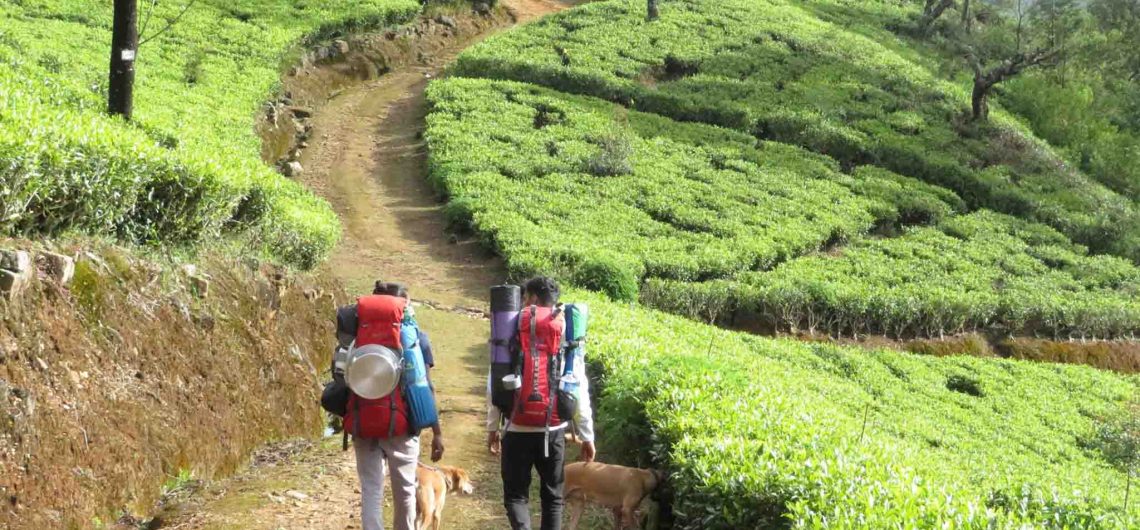The Pekoe Trail is a newly established long-distance walking trail in Sri Lanka. It covers 300 kilometers (185 miles) of the central highlands of the country. It is also considered the first ever long-distance walking trail, which provides a unique experience for hikers, trekkers, and nature lovers all over the world.
The Pekoe Trail consists of 22 stages where the trekkers will cross beautiful mountains, lush greenish tea plantations, desolate and tropical forests, grasslands, mini waterways, and traditional villages. This is an ideal trail, not only for experienced hikers but also for newbies. If you are someone who loves to walk through any stage of the Pekoe Trail, you will see fantastic views throughout the trek. The beauty of the waterfalls, the sounds of the wild animals, and the sudden changing climate will surely bring you an unforgettable, unique experience.
The Pekoe Trail was initiated under the funds of the Serendipity Trail by SLTDA, the EU, and USAID. Apart from giving a unique experience to the trekkers, they also aimed to uplift the livelihoods of the rural communities in which they are located.
Different Stages of the Pekoe Trail
As we told you earlier, there are 22 stages to the pekoe trail. The first stage starts in Hanthana, the closest village to Kandy, where the trail ends at the Pedro Tea Estate of Nuwara Eliya. It connects the three major tourism cities of the country, which include Kandy, Ella, and Nuwara Eliya.
Here are those 22 stages of the pekoe trail:
- Stage 1: Hanthana to Galaha: Distance – 12.8 km
- Stage 2: Galaha to Loolkandura: Distance – 14.7 km
- Stage 3: Loolkandura to Thawalanthenna – 18.1 km
- Stage 4: Thawalanthenna to Pundaluoya – 14.1km
- Stage 5: Pundaluoya to Watagoda – 14.1 km
- Stage 6: Watagoda to Kotagala – 15.3km
- Stage 7: Kotagala to Norwood – 16.2km
- Stage 8: Norwood to Bogawanthalawa – 15.8km
- Stage 9: Bogawanthalawa to Dayagama – 16.5km
- Stage 10: Dayagama to Horton Plains – 14.9km
- Stage 11: Horton Plains to Udaweriya – 13.1km
- Stage 12: Udaweriya to Haputale – 14.8 km
- Stage 13: Haputale to St. Catherine – 13.5km
- Stage 14: St Catherine to Makulella – 9.4km
- Stage 15: Makulella to Ella – 9.5km
- Stage 16: Ella to Demodara – 8.8km
- Stage 17: Demodara to Haliela – 12.9km
- Stage 18: Haliela to Etampitiya – 13.9km
- Stage 19: Etampitiya to Lunuwatta – 18.4km
- Stage 20: Lunuwatta to Udupussellawa – 12.5km
- Stage 21: Udupussellawa to Kandapola – 16.7km
- Stage 22: Kandapola to Pedro Estate – 10.8km
Etampitiya to Loonuwatte is considered the longest stage, while the Ella to Demodara is considered the shortest stage of the above pekoe trail. Approximately, the hiker’s haves to trek around 13–14 km to completer a stage.
The name ‘Pekoe’ is an upcountry tea grade of the Ceylon tea. We can think the name comes because the trail covered many Ceylon tea estates during its different stages.
Scenic Highlights of the Pekoe Trail
- Hanthana Mountain Range
- Uragala Mountain Range
- Dumbara Valley
- Loolkondera Tea Estate
- Taylor’s Seat
- Chariot Path
- Adams Peak
- Idalgashinna
- Horton Plains
- Ella Rock
- Little Adams Peak
- Piduruthalagala Mountain
- Nine Arch Bridge
- Pedro Tea Estate
What you need to bring for the hike
- Hiking Shoes
- Raincoat
- A hat/cap
- Water
- Leech Socks
- Leech Protections
- First Aid
- Trekking Poles
The trekking through the Pekoe Trail is available year-round, but you should note that the rain can happen any month. So, you must be ready for that before the walk starts. There are some certain accommodation options available through the Pekoe Trail.
Here, we can suggest some camping sites around the trail:
- Ravana Camping 360 in Delthota
- Haritha Kanda in Bogawanthalawa
- Bopaththalawa Camping Site
- Devil’s Stair Camping (Udaweriya)
Final Words:
The Pekoe Trail is a newly established walking trail in Sri Lanka. It is well suited for someone who loves hiking, trekking, walking, or exploring the beauty of central Sri Lanka. There are 22 stages, and you can choose the best one or many according to your wishes. If you need a foreigner who is looking for a guide or support for the Pekoe Trail, you can simply contact Mahaweli Tours and Holidays. Whatsapp: +94777 111553
.
.
(Cover Image Credit: Haputale Oliver )



